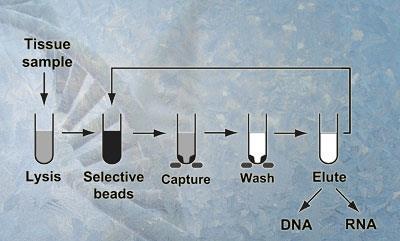A method for DNA and RNA extraction could aid cancer research
Scientists from Sweden have devised a technique that extracts both DNA and RNA from frozen tissue in a bid to improve large-scale extractions from samples stored in biobanks, which could aid cancer research.
Tobias Sj?blom and colleagues from Uppsala University used magnetic silica beads to target and extract DNA and RNA from tissue samples. Because DNA competes with RNA to attach to the beads, the DNA can be recovered first. ’The technology fulfils an unmet need, so has a huge potential impact on tissue biobanking,’ says Lucy Mathot from Sj?blom’s team.
High quality DNA and RNA preparations are necessary to study genes responsible for cancer and to identify which cancer medication to use. Researchers prefer to carry out analyses using tissues frozen from fresh because the fragments they can get from these samples are longer and better preserved than with alternative methods. Current column-based techniques for the serial extraction of DNA and RNA are labour-intensive so are not suitable for large scale applications and the automation needs of cancer biobanks.

Sj?blom’s team broke down the tissue samples by grinding them with a chaotropic salt solution, which helps to break down the DNA and RNA, and then added the magnetic silica beads. When the beads attached to the DNA, they were able to recover the samples with a magnet. Then they captured the remaining RNA in the same way.
Bert Vogelstein, a cancer researcher at the Johns Hopkins University School of Medicine in the US says: ’The technique looks like it will be quite useful for preparing precious samples for next-generation sequencing analysis.’
In the future, the team plans to implement the procedure on a robotic platform to enable parallel sample processing.
Jennifer Newton
Link to journal article
Efficient and scalable serial extraction of DNA and RNA from frozen tissue samplesLucy Mathot, Monica Lindman and Tobias Sj?blom,?Chem. Commun., 2011, 47, 547DOI:10.1039/c0cc02248a






No comments yet